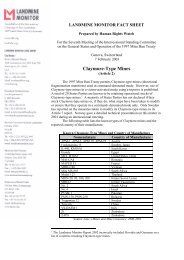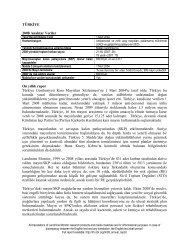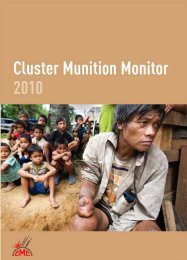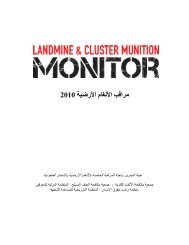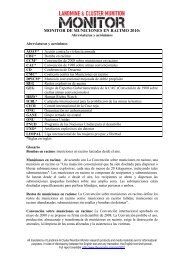Download PDF - Landmine and Cluster Munition Monitor
Download PDF - Landmine and Cluster Munition Monitor
Download PDF - Landmine and Cluster Munition Monitor
Create successful ePaper yourself
Turn your PDF publications into a flip-book with our unique Google optimized e-Paper software.
<strong>Cluster</strong> <strong>Munition</strong> <strong>Monitor</strong> 2012<br />
Stockpile Destruction<br />
• A total of 19 States Parties have reported the destruction of 744,231 cluster munitions containing 85.8 million<br />
submunitions. This represents the destruction of 68 percent of cluster munitions <strong>and</strong> 60 percent of explosive<br />
submunitions declared as stockpiled by States Parties.<br />
• In 2011, ten States Parties destroyed more than 107,000 munitions <strong>and</strong> 17.6 million submunitions. States<br />
Parties Hungary, Portugal, <strong>and</strong> Slovenia completed destruction of their stockpiled cluster munitions in 2011.<br />
• Two of the biggest stockpilers have destroyed the majority of their stocks: Germany had destroyed 66 percent<br />
of its stockpile (63 million submunitions) by the end of 2011, while the United Kingdom (UK) had destroyed<br />
72 percent of its stockpile (38 million submunitions) by April 2012.<br />
• Almost all of the 18 States Parties with stockpiles left to destroy have indicated they will complete this task<br />
within the convention’s eight-year deadline. Several major stockpilers have indicated they will complete<br />
destruction well in advance of the deadline, including the Netherl<strong>and</strong>s (by the end of 2012), the UK (by the<br />
end of 2013), Sweden (“no later than 2014”), Italy (by 2014), Japan (by February 2015), <strong>and</strong> Germany (by<br />
the end of 2015).<br />
Retention<br />
• Most States Parties that have made a formal statement have said that they will not retain any cluster munitions<br />
or submunitions for training <strong>and</strong> development purposes.<br />
• Ten States Parties are retaining cluster munitions <strong>and</strong>/or submunitions for training <strong>and</strong> research as permitted<br />
by the convention. Belgium, Germany, the Netherl<strong>and</strong>s, <strong>and</strong> Spain have indicated they each intend to keep<br />
hundreds of cluster munitions <strong>and</strong> more than 15,000 submunitions. Others that intend to retain cluster<br />
munitions <strong>and</strong>/or submunitions are the Czech Republic, Denmark, France, Sweden, Switzerl<strong>and</strong>, <strong>and</strong> the UK.<br />
Contamination<br />
• At least 24 states <strong>and</strong> three other areas are contaminated by cluster munition remnants, including unexploded<br />
submunitions. Ten contaminated states have ratified the Convention on <strong>Cluster</strong> <strong>Munition</strong>s, committing to<br />
clear their l<strong>and</strong> within 10 years, including heavily affected Lao PDR <strong>and</strong> Lebanon.<br />
• Chile has been added to the list of states contaminated by cluster munition remnants after it formally<br />
acknowledged in April 2012 that it has unexploded submunitions resulting from the use of cluster munitions<br />
on testing/training ranges.<br />
• Non-signatories Cambodia, Serbia, <strong>and</strong> Vietnam are heavily affected by cluster munition remnants, as are the<br />
disputed areas of Nagorno-Karabakh <strong>and</strong> Western Sahara.<br />
• Another 14 states may also have a small amount of contamination from past use of the weapon.<br />
Casualties<br />
• As of 31 July 2012, cluster munition casualties were reported in 30 countries, including 16 States Parties <strong>and</strong><br />
signatories to the Convention on <strong>Cluster</strong> <strong>Munition</strong>s, as well as in three other areas.<br />
• At least 17,194 cluster munition casualties have been confirmed globally through the end of 2011, but a better<br />
indicator of the number of cluster munition casualties is the estimated total of between 20,000 <strong>and</strong> 54,000.<br />
• Where the status was recorded, civilians accounted for the majority (94 percent) of casualties. Most civilian<br />
casualties were male (83 percent) <strong>and</strong> a significant proportion were children (40 percent).<br />
• In 2011, based on incomplete data, at least 55 new cluster munition casualties were confirmed in Cambodia,<br />
Iraq, Lao PDR, Lebanon, <strong>and</strong> Sudan, as well as Western Sahara.<br />
Clearance<br />
• In 2011, more than 52,845 unexploded submunitions were destroyed during clearance operations of some<br />
55km 2 of area across 10 states <strong>and</strong> two other areas. This data is, however, known to be incomplete.<br />
• Five contaminated States Parties <strong>and</strong> signatories conducted clearance of unexploded submunitions in<br />
2011: Croatia, Iraq, Lao PDR, Lebanon, <strong>and</strong> Norway. Ab<strong>and</strong>oned cluster munitions were also cleared in<br />
Afghanistan. The bulk of the clearance in 2011 was reported in State Party Lao PDR, the world’s most<br />
contaminated country.<br />
• In 2011, clearance was also conducted in non-signatories Cambodia, Libya, Serbia, South Sudan, <strong>and</strong><br />
Vietnam, as well as Nagorno-Karabakh <strong>and</strong> Western Sahara.<br />
• Signatory the Republic of Congo is believed to have completed clearance of unexploded submunitions in 2012,<br />
while non-signatory Thail<strong>and</strong> completed clearance of its sole cluster-munition-contaminated area in 2011.<br />
2



